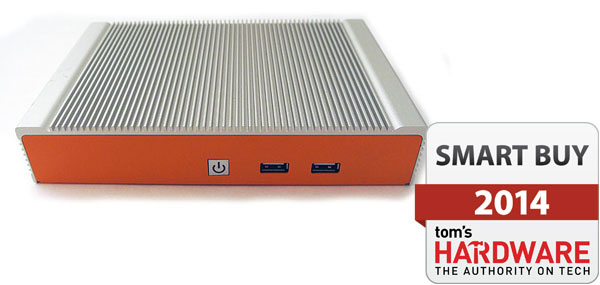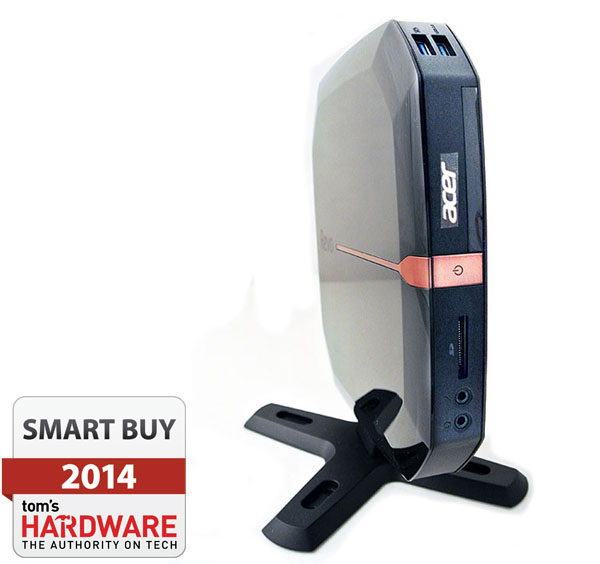Seven Small (But Powerful) Mini-PCs, Reviewed
Four Mini-PCs Receive Special Recognition
Why you can trust Tom's Hardware
I've written a handful of mini-PC round-ups now, and they're typically like comparing apples and oranges. With so many possible applications for a capable, compact PC, it's really quite hard to call one better than the others. Having said that, I will acknowledge the products that stood out in specific categories.
To start, allow me to concede that absolute dimensions don't affect me as profoundly as they might influence the buying decision of someone else. Space on my desk is sometimes at a premium, but I'm not swayed by the difference between Gigabyte's 4.5" x 4.2" x 1.1" Brix and Zotac's 5" x 5" x 1.8" Zbox nano, for example. But the quest for smaller enclosures may be more relevant in corporate environments or very specific client installations.
Consumer-Oriented Ultra Compact: Zotac Zbox nano ID65
If you want a tiny PC, but don't want to make the compromises demanded by the NUC devices we looked at today (some of Intel's newer models do add some of the functionality we were missing today), then Zotac's Zbox nano ID65 is a very solid alternative. In exchange for bigger dimensions, you get a platform that can accommodate a 2.5" storage device, includes a memory card reader, an optical S/PDIF adapter, and two external audio jacks. You also get an IR sensor for communicating with a media center remote, if you're so inclined to buy one.
The versatility is awesome in such a small form factor. Out of the box, this is a powerful Core i7-based PC (of course, that's the dual-core mobile version). Add an external Blu-ray drive and the aforementioned remote for a great HTPC. Drop it on a desktop and it uses laughably little space. Or, you can render it invisible by mounting it to the back of a monitor.
My biggest complaint is the single-channel memory architecture, which has a measurable impact on gaming performance. Moreover, we know this isn't going to change when the Haswell-based Zbox nano ID68 shows up. Nevertheless, the ID65 is one of the best-priced, most powerful mini-PCs selling for under $600.
Embedded Ultra Compact: LGX ML300
The ultra-compact form factor might make the most sense in corporate and industrial environments. So, it only makes sense that a fanless PC with no moving parts inside would make a great fit. So long as the passive cooling is effective, there's little maintenance to worry about and zero mechanical failure points.
Expansion is made possible by extra space inside the LGX ML300, even though the enclosure is still really small. What's more, in most of our tests, the thermal results were surprisingly comparable to the actively-cooled competition.
With all of this in mind, Logic Supply's ML300 hits the important check-boxes of a well-built embedded PC. The chassis alone sells for $129, if you'd like to take a stab at building it up yourself, we could see the enclosure serving as the foundation for a special project or two.
Budget Mini-PC: Acer Aspire Revo RL80-UR22
Acer's Aspire Revo RL80 finished in the back of most of our benchmarks. So why do I like it? Two reasons. First, the performance spread between the Revo and some of the other offers is typically pretty narrow. Second, the $430 price tag, which includes an operating system, is less than half of what you'd pay for most of the other contenders.
As if that's not enough, the Revo comes with a wireless mouse and keyboard, and Windows is pre-installed. Plug in a monitor and you're off to the races. Acer's submission is a little larger than some of the other options in our round-up, but its footprint is still diminutive, particularly on its vertical stand. And it can also be mounted to a monitor, tucked out of the way completely.
Even though the Revo isn't fast relative to today's story, it has plenty of power for a home desktop. Remember, it was only a couple of years ago when we were looking at painfully slow Atom-based PCs. The enthusiast community won't like this thing's limited gaming performance, its restrictive firmware, or the hard-to-remove 2.5" disk drive. But for the price, the Revo is a fantastic little machine.
Mini Gamer: ASRock VisionX 420D
At about 8.5" square, ASRock's VisionX 420D is about twice as large as the NUC-sized devices in this round-up. Then again, it's dwarfed by a standard DVD player, and is smaller than most of the HTPCs you'll encounter with optical drives. Without the thermal restrictions imposed by smaller devices, its Haswell-based Core i5 CPU maintains a 2.5 GHz based clock rate that propels the VisionX to the front of our platform-oriented benchmarks. And when it comes to graphics, the discrete Radeon HD 8850M with 1 GB of GDDR5 is in a league of its own. The included 802.11ac-capable wireless solution is fantastic, too.
Equipped with the internal Blu-ray option, ASRock's VisionX becomes a high-end home theater and gaming PC capable of handling 3D content at the resolutions and quality settings PC gamers want to use. It's classy-looking enough to live in your living room, but also the perfect size to take to LAN party. If I were still in a dorm with limited room for electronics, the VisionX would be on my wish list.
My biggest issue with the ASRock box is its $850 price tag. Add $130 for a copy of Windows 8.1 Professional and you're just short of $1000. Fortunately, that's not much more expensive than some of the other contenders in today's story. At that price we have to start thinking about similarly-priced mobile devices as well, although it'd be difficult to find something with comparable graphics ability.
Current page: Four Mini-PCs Receive Special Recognition
Prev Page Temperature BenchmarksGet Tom's Hardware's best news and in-depth reviews, straight to your inbox.
Don Woligroski was a former senior hardware editor for Tom's Hardware. He has covered a wide range of PC hardware topics, including CPUs, GPUs, system building, and emerging technologies.
-
outlw6669 Not a single AMD based SFF PC?Reply
I am disappoint, this would be a great area for AMD to show their competitiveness. -
ta152h @outlw6669I built one based on the A6 5200, and it's perfect for what I need it for. It's low power, more than fast enough for what 99% of the people do, quiet, and inexpensive. I'm a little surprised they didn't choose something based on the Jaguar for that reason, but it might just be a situation where nothing with one was sent to them for review. Certainly this is a poor representation, without both Jaguar and Bay Trail missing. I got to the first page, read what they had, looked at the cases, and moved on. Reading about different versions of Ivy Bridge and Haswell and how they compare to each other is profoundly uninteresting.Reply -
m32 I wouldn't mind having a small system like this. Maybe Mid-Year when everyone's CPU/APUs are out, I'll have the chance to make a smart buy. Thanks for the article. :)Reply -
mesab66 It is interesting that by going slightly larger with the enclosure space (still keeping within cube/rectangle/media player shape) opens up the possibility of so much more power....dedicated gfx, full cpu, etc etc., and, can be cheaper to build - depending on the users requirements.......of course, at the cost of power requirements, etc. I'm thinking most folk would ideally chose a slightly larger form factor for living room/media pc duties.On the other hand, if constraints are tight (form factor in this article) and the end user's requirements match, then these options are worth considering.Reply -
s997863 Power. I don't care about no power. Where's the love for the old games? If I want to play some of the classics which just don't emulate properly, I have to hunt for a heavy old Pentium3 box and try to get it working. How about a cheap mini PC with miniaturized legacy hardware for full compatibility to dual-boot win98 & XP, with gameports, VGA & S-Video, PS/2 & USB, IDE & SATA external ribbon & power connectors, & a turbo button for choosing between 2 processors 200MHz & 3GHz?Reply -
vertexx I am a huge fan of compact systems. Almost everything I have built has been ITX. But I've had a hard time with the NUC form factor. As a desktop, I think it's actually too small. One of those boxes would get lost on my desk, continuously being pushed around by other clutter. Now, if I had a hutch with an optimally sized cubby, that might be a different story.Reply
VESA mounted on the back of a monitor, these look really clunky, and I'd rather go with an AIO kit using the thin mini-ITX form factor where I have more control over processor choice.
I'd be more excited if this technology and form factor were applied in a more interchangeable system with a standardized GPU socket. I really like what ASRock and Gigabyte have done with their compact systems. They're not as compact, but having something a little more substantial on my desk is a good thing, and they pack a lot of punch. I just wish the standards were developed to allow builders to replicate that feat - pipe dream, I know.
One thing is for sure, AMD needs to develop it's own equivalent of the NUC and thin Mini-ITX. The success of it's Kaveri line I think would be helped out by innovation in form factor. -
axehead15 I think you should compare the Mac Mini to these, that way we can see how it adds up.Reply



